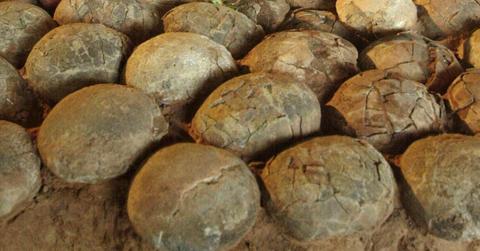Villagers in India Unearthed ‘Sacred Stones.’ Scientists Are Stunned by What the Finds Turned Out to Really Be.

Sacred stones collected by villagers in India have been identified as fossilized eggs of the titanosaur dating back between 145 and 66 million years. This photo shows fossilized protoceratops eggs between 100 and 65 million years old.
Jan. 2 2024, Published 1:01 p.m. ET
In the heart of central India's Madhya Pradesh, scientists from the Birbal Sahni Institute of Palaeosciences have made a remarkable discovery, unraveling the mystery behind sacred stones known as "Kakar Bhairav" in the village of Padlya.
For generations, villagers have considered these palm-sized, smooth stones as divine symbols providing protection for their farms and cattle.
Unbeknownst to the villagers, experts closely examined a collection of these stones obtained from a local resident named Vesta Mandaloi and his family.
Contrary to popular belief, these objects were identified as fossilized eggs laid by titanosaurs, a large dinosaur species dating back to the Cretaceous era, between 145 and 66 million years ago, according to The Times of India.
The titanosaurs are massive long-necked dinosaurs whose existence was first recorded in 1877. The revelation suggests that these dinosaurs may have exhibited behavior similar to modern-day crocodiles and birds, burying their eggs.
This finding adds to the growing body of evidence pointing to the existence of this dinosaur group in Madhya Pradesh.
Scientists from Delhi recently made a significant discovery in the same region, unearthing 256 fossilized titanosaur eggs across 92 nesting sites, according to a journal published in PLOS One.
This suggests that the Narmada Valley might have served as a breeding ground for the creatures. The closely packed nests imply a potential herd behavior, indicating that the dinosaurs laid their eggs together in colonies, leaving them to fend for themselves — a behavior not commonly associated with parental care, according to Susannah Maidment, a curator and researcher at the Natural History Museum in London.
Never miss a story — sign up for the Front Page Detectives newsletter. Be on the scene the moment news breaks.
Maidment explained, "We think that sauropods like the titanosaurs lived in herds because of their preserved footprints and trackways, and it seems that they also nested together as well, like some birds."
While remains of the titanosaur have been discovered worldwide, about 75% of its species were believed to have roamed the modern-day area of Patagonia in South America, according to the Natural History Museum. Among the largest titanosaurs was Patagotitan mayorum, with colossal bodies estimated to span over 120 feet, equivalent to the length of two bowling lanes.
Become a Front Page Detective
Sign up to receive breaking
Front Page Detectives
news and exclusive investigations.
